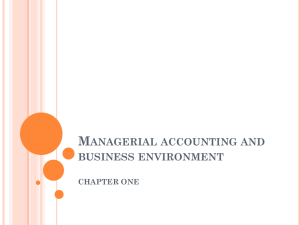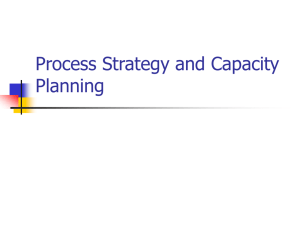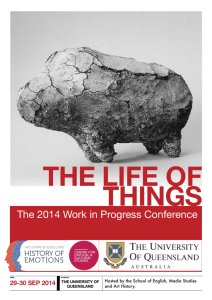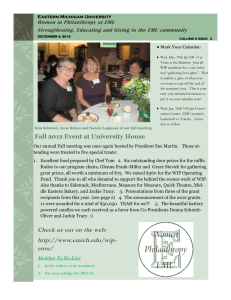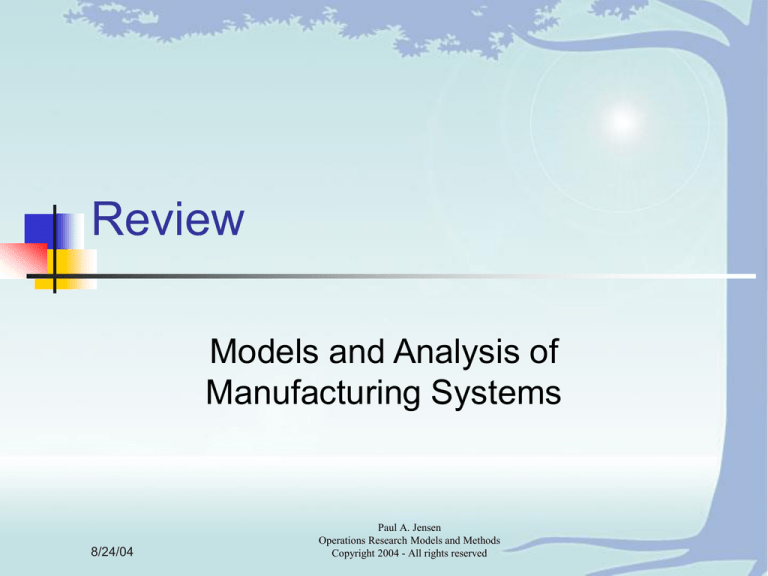
Review
Models and Analysis of
Manufacturing Systems
8/24/04
Paul A. Jensen
Operations Research Models and Methods
Copyright 2004 - All rights reserved
Purpose of the course:
Provide an understanding of problems and
issues in manufacturing design
Build flow models embodying the
components of the manufacturing process
Identify waste in the manufacturing process
Use models to quantify waste
Use operations research tools to analyze
models and make decisions
2
The production system may
be very complex
R1
R2
R3
M1
M1
M1
M1
M1
M2
M1
M1
M3
M1
M1
M4
M5
M6
M7
M1
M1
M5
M1
M2
M3
M4
Of f ices
V
M1
M1
M6
Ope rations
M achine s
Raw M ate rials
Resource s
3
The process model
R1
R3
R2
11
5
1
12
6
2
Raw Materials Inventory
Processing Operation
3
13
7
14
4
Inspection
8
Delay
15
9
16
10
17
18
19
20
Finished Goods Inventory
4
Multiple products
Product A
R1
Product B
R1
R3
R2
Product C
4
1
1
5
2
2
6
3
3
A
4
R2
8
R3
4
1
2
9
5
3
A
10
7
6
VB
8
11
VA
7
A
12
13
VC
5
Flow Analysis
R2
R1
Grouping and waste
And, OR, Proportion
Nodes
Cycles with and
without waste
Flow ratio
Unit time
Complex Networks
5
6
R3
3
1
2
A
7
4
A
8
6
Defects and Inspection
R2
5
R3
3
R1
1
R2
8
R3
4
1
2
6
2
9
5
A
7
3
A
10
6
4
11
A
8
7
A
Operation Defect Rate Scrap Rate
Flow Ratio
––––––––––––––––––––––––––––––––––––––––––––
1
0.1
0
1.929
2
0.2
0
1.929
3
0
0.28
1.929
4
0.1
0
1.543
5
0
0.1
1.543
6
0.2
0
1.389
7
0
0.2
1.389
8
0.1
0
1.959
9
0.1
0
1.959
10
0.3
0
1.959
11
0
0.433
1.959
12
0.1
0
1.111
13
0
0.1
1.111
––––––––––––––––––––––––––––––––––––––––––––
12
13
7
Work in Process
WIP = Flow rate*residence time
1
Raw
De lay
M aterial
Computing WIP
Evaluating WIP
4
5
De lay
Inspect
3
2
Ope r.
Oper.
1
Time A
min.
Time B
min.
Flow
1.272
Ratio
WIP A
WIP B
Oper.
WIP A
Unit
Value
WIP
value
1
De lay
10
9
7
8
Ope r.
De lay
6
Inspect Finis hed
Goods
2
3
4
5
6
7
8
9
10
5
20
4
25
18
30
5
10
10
20
12
25
10
30
15
1.272
1.272
1.272
1.272
1.111
1.111
1.111
1.111
8.3325
9.2583
13.888
27.775
2.3146
13.888
5.3
10.6
2.65
10.6
10.6
21.2
2.12 11.573
12.72 23.146
2
3
4
5
6
7
8
9
20
5.3
20
2.65
20
10.6
20
2.12 11.573 8.3325 13.888 2.3146
20
20
50
50
50
0
106
53
212
42.4 231.46
416.63
694.38
115.73
10
Total
117
1
132
56.778
129.19
10
Total
56.778
50
0 1871.6
8
Inventories
Raw Materials
Inventory Level
s+Q
TC = [aK/Q] + [hQ/2] + hs
Lot size: Q* = 2aK/h
Cycle time: t* = Q*/a.
1
s
0
0
Q/a
2Q/a
3Q/a
4Q/a
5Q/a
6Q/a
Time
Finished Goods
Inventory Level
TC = [aK/Q] + [(p -a)hQ/2p] + sh
Lot size: Q* = 2apK/(p - a)h
Cycle time: t* = Q*/a.
s+Q
10
s
0
0
Q/a
2Q/a
3Q/a
4Q/a
5Q/a
6Q/a
Time
9
Production in Lots
Production and transfer lots
Effects on machine capacity
T = T s + T p where T s =
VQt
products
j sj
j
and T p =
V jtpj
products
Effects on WIP
Processing: Depends on the production
and transfer lot
Queuing delays: Depends on lot size
10
Variability
Poisson and Nonpoisson Systems
M1
M1
Queue
Operation with Delay
š0 =
s–1 n
(s)
n=0 n! +
Machine Station with Queue
(s)s
s!(1 – -1
)
š s
sss+1š 0
Lq =
=
(1 – )2 s!(1 – )2
11
Queuing Networks
1
Raw
Material
Oper.
Time X
min.
Time Y
min.
1
Delay
4
5
6
Delay
Inspect
Delay
3
2
Oper.
7
Oper.
Delay
10
9
8
Inspect
Finished
Goods
2
---
3
5
4
---
5
4
6
---
7
12
8
---
9
5
---
10
---
12
---
20
---
15
10
Depends on machine assignment
Depends on product demands
Depends on operation times
Depends on flow ratios
12
Material Movement
Types of layouts
Criterion for comparison
The Craft method
To
From
A
B
C
D
A
E
F
G
H
5
B
3
C
1
4
I
J
1
9
1
Y
20
1
2
A
3
B
4
C
5
D
D
6
7
F
8
G
9
H
10
I
0
10
20
30
6
1
F
8
3
2
5
J
G
0
2
E
E
10
9
40
50
X
H
6
8
I
J
13
Kinds of Problems
Fixed machine assignments and capacities
Fixed machine assignments and product mix
Find the bottleneck
Find the product mix
Compute queuing delays, WIP, throughput time
Select capacities (number of machines)
Compute queuing delays, WIP, throughput
time
14


